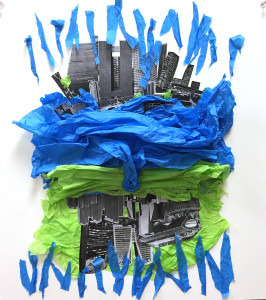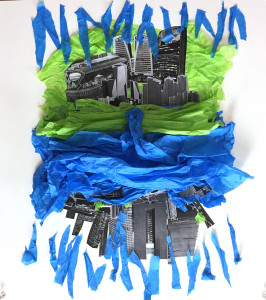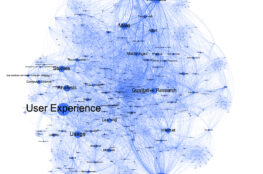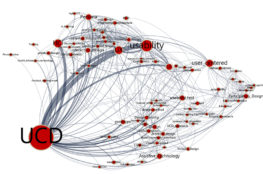“Sustainable design” is a commonly used today, but I didn’t know how graphic designers can be involved with sustainable design. I thought that the sustainable design is a branch of design field, therefore I just try to use green or recycled materials for representing sustainable design. However, Robyn Mitchell says “It isn’t a separate branch of design, or an optional add-on to an existing design. In this day and age, all design should be sustainable – in terms of environment, economy and society.” Philippe Intraligi also states that “much more than just sticking a ‘green’ label on existing products. It involves function, material and packaging choices.” Then, what should we do for the sustainable design as designers?
1. They need to be simple and enjoyable.
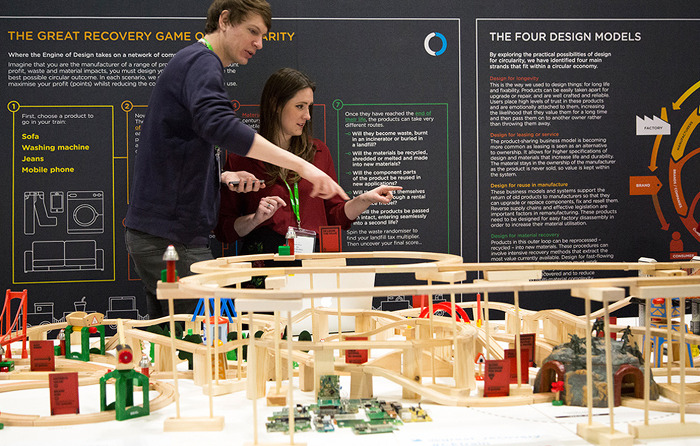
The most important thing for sustainable design is the way we say our messages to consumers or societies. “Negative or punishing messages aren’t a real motivator for behavior change,” Sonora Beam says. Designers need to avoid punishing, but their designs should be able to get the attention of the audience while being enjoyable, interactive and meaningful. For example, the game of Circularity made by Thomas Matthews, a design agency in London, makes learning about sustainability simple and enjoyable.
One more example of an enjoyable design is the roundabout Playpump in South Africa. It also shows an easy and interesting way to solve environmental problems.
The two examples above show people enjoy interacting with both designs created to educate about sustainability, as well as to show people how to solve problems around issues with sustainability. People enjoy these designs because of they easy to join in and the activities fun for kids and families.
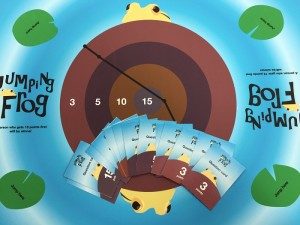
For the first project in a graduate class I was in we worked on a project called “Soil”. Andrew and I had to design a board game. We decided to design a game that was enjoyable and simple for people that could get them engaged with information involving local soil in an easy and exciting way. Thus, we designed a game called “Jumping frog”. People play with small folding paper frogs and the ground graphic that looks like a target. Each sector earns different points when frogs land different sectors or ground. People get a question card, and the difficulty of question cards is changed the number of points they are awarded. If a player can correctly answer, then the player gets the points for that card. The first player to get 15 points, is the winner. The game was enjoyed by our classmates and faculty during the day in class.
2. The need to make a direct connection with specific topics of sustainability
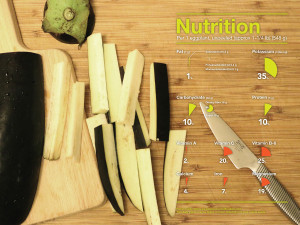
During the Fall semester in 2015, I’ve worked on a lot of projects for this class, and I’ve got a lot of reviews from classmates and instructors about my projects. According to their reviews, my projects were good to see and well crafted, but they need to be more specific or relate more with specific sustainable issues. I’ll show two examples of the other projects from the class. This is the final information design about local food. According to the objectives of this project, there were specific directions that needed to be followed. One was “Each of our disciplines has a different way in which we can address issues related to food and in turn help people and communities reconnect to some of things that have worked to sustain culture and society for generation, not mention health and well being,” and another directions was “The visuals that you use for this should be directly related to the content being represented. The goal is to create a compelling piece that helps strengthen a viewer’s connection to food, food production, food preparation or the idea of community surrounding food.” As you see, I used a local eggplant and some nutritional information about eggplant for my information graphic, however, it just shows the nutrition information, and doesn’t have any connection with specific sustainable issues on local area. Thus, one of instructor told me that “The one thing the poster doesn’t do in a clear way is connect this information back to an issue of sustainability in a direct way. The nutritional information is there but the poster doesn’t make a direct or implied connection between that information and a specific issue. Work on determining ways that this type of information can tell a story or be a part of a narrative that connects to the audience in a meaningful way connected to issues of sustainability.”
The images above are the final collage I created about the water problem related to urban flooding. I tried to represent the problem and the way to solve the problem through the creation of this collage. However, as you see it seems too abstract, and does not including detailed information about the issue and the solution. It should have had more detailed information. One of the reviews I recieved from an instructor said ” Your overview of the flooding problem, as presented on your blog, is good start but more understanding is required at the graduate level; for example, the solution to needs more than larger canals to drain water. The green space has a function in infiltration as a critical point of the water cycle on our planet — your use of “green space” conceptually addresses this. With more time this piece could go a long way in communicating this important issue to policymaker and city government.” As you see above these two images of my class project results, show my project didn’t have enough detailed connection with a specific problem with my case study, even though it was a well crafted. Thus, to take this project further I should consider how to make a direct connection with specific sustainable issue.
3. The need to think deeply and critically.
I’ve been talking about the things I learned from this class and what things are needed to move forward with my works. Thus, to move forward with my research and what I pan on creating then I need to be aware of making the simple, enjoyable, detailed and have a direct connection with specific issues. So the question I ask myself is what should design to meet those expectations and what is needed to me to progress in my future works? I think that I already know the answer, and it involves “Critical Thinking.” While I was doing reading, researching and designing, I found that I just scratched the surface of the information around designing for sustainability, and I hadn’t thought as critically and deeply as the subject deserves. I could make the excuse for myself that I didn’t have enough time to think critically or I had lots of other things to do and although that is true, I do have to try to critical thinking for my projects as graduate level student. So, what should I do for critical thinking? I’ve found a tip for critical thinking on the website of GCF.
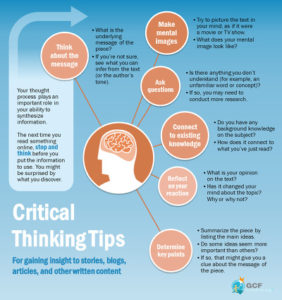
As you can see in the picture, there are some steps for critical thinking. It does not cover the whole process of the critical thinking, but it will be good for me if I keep in mind these steps, whatever I want to do. Through critical thinking, I can make better conclusions for my writing or research, because it would be helpful to synthesize the information, not just listing the information. I’ve attached the short video below that I found on the GCF website. It is about the way to synthesize information and it is important and educational information that would benefit a lot of people.
From now on, I will try to do critical thinking, whatever or whenever I do for my future work becoming better and better. Think critically and deeply!
References
- Robyn Mitchell. “How you can use sustainable design and save the world”. Creative Blog. Creative Blog, 15 Jan. 2014. web. 12 Dec. 2015
- Clive Roux. “Sustainability in EGD/XGD”. SEGD. SEGD, 20 May 2014. web. 12 Dec. 2015
- Aaris Sherin. “Sustainable Motivators in Graphic Design”. Graphics. mediabistro. web. 12 Dec. 2015
- “TGR Stand at Resource 2015”.Thomas.Matthews. Thomas Matthews, 2015. web. 12 Dec. 2015
- “Flooding in urban Areas (urban flooding), Integrated Flood Risk Analysis and Management Methodologies. Acknowledgments & Disclaimer
- Rachelle Oblack. “Urban Flooding”. about education. about.com, 2015. web. 10 Oct. 2015
- Christopher P. Konrad. “Effects of Urban Development on Floods”. UCGC: science for a changing world. U.S. Department of the Interior. web. 10 Oct. 2015
- Daniel J. Kurland. “What is Critical Thinking?”. How the Language Really Works: The Fundamentals of Critical Reading and Effective Writing. www.criticalreading.com, 2000. web. 14 Dec. 2015
- “Critical Thinking”. Thoughts on Problem Solving. Thoughts on Problem Solving. web. 14 Dec. 2015
- “Use information correctly”. GCF: LearnFree.org. Goodwill Community Foundation, 1998-2015. web. 14 Dec. 2015
- “Defining Critical Thinking”. The Critical Thinking Community. Foundation for Critical Thinking, 2013. web. 14 Dec. 2015

